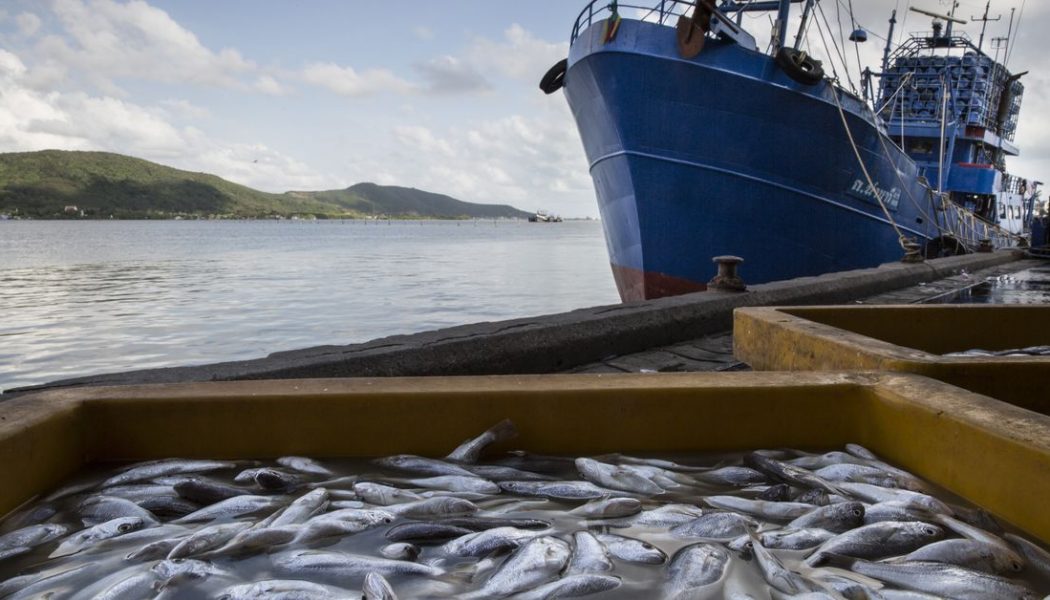
A tracking system designed to help ships avoid crashing into each other has become an important tool for spotting bad behavior on the high seas. Researchers can now put a spotlight on corporations that dominate fishing in unregulated international waters where it’s easier to get away with overfishing. And it’s giving us a better idea of how widespread slave labor could be on fishing vessels.
Two recently published papers use this technology, the maritime Automatic Identification System (AIS), to make high-seas fishing a little less mysterious. The first study, published in the journal One Earth on December 18th, traces the origins of thousands of high-seas fishing vessels back to big-time corporations that keep store shelves stocked with seafood. Other researchers use AIS to reveal telltale markers of forced labor on fishing boats, which were published today in the journal Proceedings of the National Academy of Sciences (PNAS). That all makes it easier to make companies answer for any abuses they commit at sea.
The technology, the maritime Automatic Identification System (AIS), has actually been around for about two decades. Basically, vessels carry around a box that sends out radio signals that anyone else can pick up on. Those radio signals share information about the ship, an identifying number, and other things like its size, course, and speed. That’s supposed to help vessels spot each other so they don’t get in each other’s way.
Satellites can pick up on those radio signals, too, giving researchers a new set of eyes on the vast high seas — international waters that make up almost two-thirds of the world’s oceans. In 2014, Google and environmental nonprofit organizations Oceana and SkyTruth launched Global Fishing Watch, an initiative to track fishing vessels around the world as a way to potentially prevent and hold vessels accountable for abusive practices. Global Fishing Watch, which is now its own nonprofit, uses AIS and smaller national vessel tracking systems to create a near-real time map tracing the movement of about 60,000 commercial fishing boats.
That was a game-changer for Jennifer Jacquet, an associate professor in New York University’s Department of Environmental Studies. She turned to Global Fishing Watch to identify for the first time seafood companies that own vessels fishing on the high seas. “Just in the course of my project, new technology enabled the research in a way that wasn’t there when the project began,” Jacquet tells The Verge. Her team put together a list of the top 10 corporate actors in high-sea fishing in 2018, which includes Dongwon Group, which owns the popular tuna brand StarKist.
“There are few laws and regulations that apply to the high seas, and that is being used by these companies to do whatever they want,” says Daniel Pauly, an acclaimed marine biologist who has documented the demise of fish populations around the world. He has pushed for a complete ban on fishing on the high seas. (Pauly is on the board of directors for Oceana but was not involved in Jacquet’s study.)
Modern-day slavery is another problem on the high seas. Up to 26 percent of 16,000 industrial fishing vessels were likely to use forced labor, the PNAS study published today found. As many as 100,000 people are estimated to work on those ships.
The study authors used AIS data from 2012 to 2018 to study the behavior of vessels that had already been documented using slavery. That allowed them to see how those ships behaved differently from other vessels: they stay away from ports and spend a lot more time on the high seas, for example. The researchers used that information to build a computer model that can identify vessels showing behaviors that suggest that they might also rely on forced labor.
“This research, this paper, it could not have been done five years ago,” says Gavin McDonald, lead author of that study. “There would have just been no way to track this many vessels at a global scale without Global Fishing Watch.”
There’s still a lot of elbow grease that goes into turning the data from AIS into research that can have an impact on how responsibly the fishing industry operates. Data scientists at Global Fishing Watch had tried to automate this process in the past, but scraping the internet couldn’t get the same results. “You end up with one level, but you actually need to dig deeper,” says Nate Miller, a senior data scientist at Global Fishing Watch who was a co-author with Jacquet.
Jacquet and Miller’s team for this project did just that. One of their colleagues found that several high-seas fishing vessels shared the same address, even though they listed different owners. She searched for the address on Google Maps, zoomed in to see the sign on the building, and tied all those ships to Pacific Fishing & Supply based in Hawaii. It fulfilled one of Jacquet’s hopes for this study, which was to identify new players on the high seas since a lot of the spotlight so far had been on Asia-based companies.
More transparency has already forced some companies to act. The Walmart Foundation funded McDonald’s study after a 2015 investigation by The Guardian and The Associated Press revealed that Walmart sold shrimp tied to slave labor.
If the high seas aren’t so lawless in the future, we may have researchers like these to thank. Their work could inform a new treaty being negotiated by the United Nations. If it comes to fruition next year, it could establish protected areas in the high seas to safeguard marine life.










